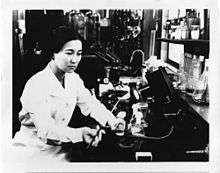Ruby Hirose
| Ruby Hirose | |
|---|---|
 Ruby Hirose at William S. Merrell Laboratories | |
| Born | 1904 |
| Died | 1960 |
| Nationality | American |
| Alma mater | University of Washington |
| Occupation | pharmacology |
Ruby Sakae Hirose (1904 – 1960[1][2]) was an American biochemist and bacteriologist. She performed groundbreaking research related to vaccines for polio.
Life
Hirose earned her master's degree in pharmacology from the University of Washington in 1928.[3] She then moved to the University of Cincinnati where she completed her doctorate in 1932. She worked at the University of Cincinnati[4] until being hired by the research division of the William S. Merrell Company where she researched serums and antitoxins.[5]
In 1940, she was one of ten women recognized for her contributions by the American Chemical Society.[6]
During World War II, her family was sent to internment camps, a fate she likely escaped because her work sent her to Ohio. She died in Pennsylvania in 1960, and her surviving family buried her at the Auburn Pioneer Cemetery in Auburn, Washington.[7]
References
- ↑ Ruby S. Hirose | Billion Graves Record
- ↑ Hirose, Shiusaku & Tome Kurei biography; plus Kimeo, Ruby and others
- ↑ Yoo, David (2000). Growing Up Nisei: Race, Generation, and Culture Among Japanese Americans of California, 1924-49. University of Illinois Press. pp. 61–. ISBN 9780252068225. Retrieved 14 July 2012.
- ↑ Hirose, Ruby (1933). "The Second Phase of the Thrombin Action" (PDF). Retrieved 14 July 2012.
- ↑ "Ruby Hirose". Retrieved 28 April 2015.
- ↑ "Ruby Hirose". Acc. 90-105 - Science Service, Records, 1920s-1970s. Smithsonian Institution Archives.
- ↑ Lommen, Kristy (2013). "An American-born Japanese Girl Scientist". The Auburn Pioneer Cemetery Blog. The Auburn Pioneer Cematery. Retrieved 21 March 2015.